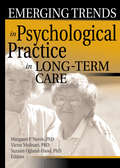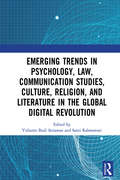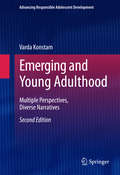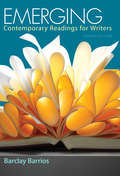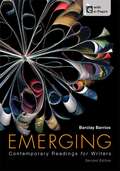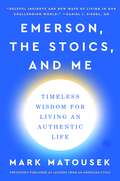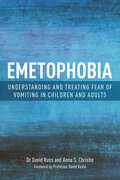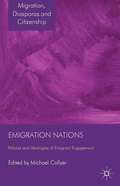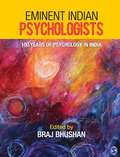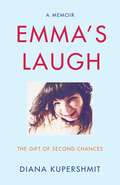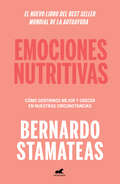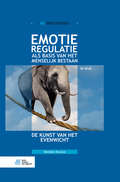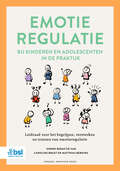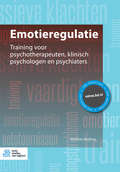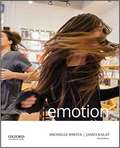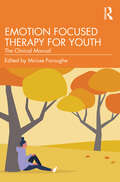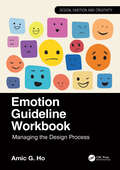- Table View
- List View
Emerging Trends for EAPs in the 21st Century
by Nan Van Den BerghRaise your organization's productivity and morale with the proper EAPs!The development of employee assistance programs (EAPs) was one of the 20th century's most important workplace innovations. Emerging Trends for EAPs in the 21st Century examines the evolution of EAPs from their origin as a way of dealing with alcoholic employees to the multifaceted EAPs in the modern workplace. Today's EAPs serve employees affected by a great number of stressors related to the rapidly changing environment of today's workplaces as well as stressors related to the balancing of work and family issues.Emerging Trends for EAPs in the 21st Century stresses the important advantages to be found in working from a strengths and solution-oriented case management approach, rather than an assessment and referral model, and of considering individuals “challenged” rather than “troubled.” Thus, you will learn that trauma and abuse, illness and struggle may be injurious, but they also may be sources of challenge and opportunity, and you'll see that every individual, couple, family, group, organization, and community has strengths that can be fortified to help those who need it.Emerging Trends for EAPs in the 21st Century will show you: the impact of today's changing workforce demography the need for workplace-sponsored services to assist caregivers and older workers sophisticated intervention skills that organizations are using to help manage crisis, change, and evolution today new ways of providing help to your employees. . . and bring you stimulating discussions and examinations of: child/elder/dependent care services prevention/interventions for older workers work/family programs critical incident interventions management consultation health and wellness promotionEmerging Trends for EAPs in the 21st Century offers insightful commentary, pragmatic information, and predictions for the future of employee assistance programs as we move into the 21st century.
Emerging Trends in Psychological Practice in Long-Term Care
by Suzann Ogland-Hand Margaret Norris Victor MolinariUpdate your knowledge of mental health services delivery in long-term care settings! Authored by experts in the field of psychology practice in long-term care (LTC), this valuable book is designed to update psychologists and educators on developments in the evolving field of geriatric mental health in LTC settings. The editors and chapter authors are scientist-practitioners who use their expertise to cover applied topics while maintaining high scientific and scholarly standards. The first section of Emerging Trends in Psychological Practice in Long-Term Care examines modifications to traditional psychotherapy techniques that make them more appropriate for long-term care patients, with chapters reviewing: group therapy in long-term care brief psychotherapy for treating depression in patients with dementia the use of autobiographical memory techniques in cognitive-behavioral treatment for depression the treatment of disruptive behaviors in LTC residents The second section covers systematic therapy approaches in LTC settings, with chapters discussing: distinctive family therapy issues in LTC an LTC systems application of behavioral treatment for depression using pleasant events a comparison of patient and staff perceptions of characteristics that contribute to the quality of LTC facilities a multidisciplinary team approach to the treatment of dementia training LTC caregivers in behavioral techniques The third section of this remarkable volume addresses the thorny ethical and legal issues unique to LTC residents, including legal definitions, requirements for obtaining informed consent from LTC patients, and confidentiality dilemmas that are unique to clinical services in long-term care. With helpful charts, tables, and fascinating case studies that illustrate clinical issues, this user-friendly text belongs on the reference shelf of everyone involved in providing mental health services to people in long-term care settings!
Emerging Trends in Psychology, Law, Communication Studies, Culture, Religion, and Literature in the Global Digital Revolution: Proceedings of the 1st International Conference on Social Sciences Series: Psychology, Law, Communication Studies, Culture, Religion, and Literature (SOSCIS 2019), July 10 2019, Semarang Indonesia
by Yulianto Budi Setiawan Santi RahmawatiThe Fourth Industrial Revolution has the potential to raise global income levels and improve the quality of life for populations around the world. Technology development of AI, self-driving, big data, the Internet of things, and many digital revolutions have changed how people interact with each other. Therefore, developing a comprehensive and globally shared view of how technology is affecting our lives and reshaping our social, cultural, and human environments is essential. There has never been a time of more significant promise, or one of greater potential peril. Today’s decision-makers, however, are too often trapped in traditional, linear thinking, or too absorbed by the multiple crises demanding their attention, to think strategically about the forces of disruption and innovation shaping our future.The main goal of the conference was to provide an outlet for papers discussing the importance and impact of industrial revolution 4.0 to influence social aspect in human life. The proceedings consist of papers covering issues on psychology, law, communication studies, culture, religion, and literature. The proceedings will provide the latest research and constitute a concise but timely medium for the dissemination.The Proceedings of the 1st International Conference on Social Sciences Series (SOSCIS 2019) will be invaluable to professionals and academics in psychology, law, communication studies, culture, religion, and literature.
Emerging and Young Adulthood
by Varda KonstamThe most distinctive feature of the Second Edition is its theoretical orientation coupled with a focus on understanding emerging and young adulthood from multiple perspectives. The updated and expanded book offers readers an opportunity to "listen to the voices" of emerging and young adults, parents, and employers, which is key to understanding this particular developmental period. In addition, the case studies provided throughout the book are diverse and detailed. The issues of emerging adulthood are complicated, nuanced, and defy easy characterizations. This book provides an opportunity to debunk many established pernicious stereotypes about emerging and young adults. The presentation of diverse voices and case material serves as a springboard for discussion and engages readers with material depicting emerging adults in the throes of working through developmental challenges characteristic of this period. In addition, the recent economic downturn has created havoc and further instability in the lives of emerging and young adults. The Second Edition focuses on the effects of - as well as possible solutions to - unemployment on emerging and young adults. A new chapter focuses on career experimentation versus career floundering, which is an important distinction. Additional new chapters address the effects of technology as well as depression and anxiety on emerging and young adults. The Second Edition examines emerging and young adulthood within a larger developmental and ecological context. In addition, it ensures that readers are well positioned to understand how the developmental demands of this period intersect with current economic, social, and political realities. It is a must-have resource for developmental, clinical child and school psychologists, rehabilitation counselors and therapists, I/O psychologists, and sociologists as well as for researchers and graduate-level students across these various disciplines.
Emerging: Contemporary Readings For Writers
by Barclay BarriosEmerging uses an inquiry-based approach and engaging readings to help students understand and write about a variety of academic texts. Based on reviewer feedback, the third edition uses its assignment sequences to pose questions about the important but unsettled issues that shape students’ lives, such as “How is technology changing us?” and “How can you make a difference in the world?” Thought-provoking, contemporary readings help them address those questions in a meaningful way. At its core, Emerging focuses on the skills necessary for academic writing in any discipline, and a thoroughly revised Part One offers concrete strategies for improving those skills: reading critically, synthesizing, arguing, using evidence, and revising. Twenty vibrant new readings keep Emerging in tune with the newest ideas that will challenge students to think beyond their own experiences—and beyond the classroom.
Emerging: Contemporary Readings For Writers
by Barclay BarriosEmerging focuses on the skills necessary for academic writing in any discipline—and offers concrete strategies for improving those skills. Author Barclay Barrios uses an inquiry-based approach to help students understand and write about a variety of texts, while innovative assignment sequences explore the important but unsettled issues that shape our lives, such as How is technology changing us?, How can you make a difference in the world?, and a central question of our time, How can we get along? Thought-provoking, contemporary readings help students address those questions in meaningful ways. Fifteen new readings and updated writing assignments keep Emerging in tune with current ideas that will challenge students to think beyond their own experiences—and beyond the classroom.
Emerging: Contemporary Readings for Writers
by Barclay BarriosHow should money be distributed? What is the future of food? How do we identify and combat stereotyping?Emerging engages students with meaningful contemporary issues so that they can develop the skills they need to address the large questions that will shape their lives. To help students learn to bridge public and academic conversations,Emerging focuses its support on building key academic skills: reading critically, synthesizing, arguing, using evidence, and revising. With a more accessible range of readings, the second edition includes substantial and shorter selections, as well as visuals and online multimodal texts that will challenge students' assumptions and spark considered writing. The print text is now integrated with e-Pages for Emerging,designed to take advantage of what the Web can do.
Emerson, the Stoics, and Me: Timeless Wisdom for Living an Authentic Life
by Mark Matousek“This is a beautiful book, full of ideas that could help restore America’s genius for freedom and promise.” —Thomas Moore, New York Times bestselling author of Care of the SoulA lifelong Emersonian scholar, teacher, and spiritual seeker reveals how American philosopher Ralph Waldo Emerson’s twelve essential teachings hold the answer to living an authentic and fulfilling life, one that is in harmony with our souls.Ralph Waldo Emerson was a spiritual revolutionary whose profound vision of human potential came to define the American character. Known as America’s original Stoic, he offered a radical message of optimism, authenticity, and self-realization that is more necessary today than ever.In this timely, remarkable book, noted memoirist and teacher Mark Matousek reveals the depths of Emerson’s extraordinary wisdom, demonstrating how his timeless philosophy can help us navigate the challenges of contemporary life. Using personal stories, psychological research, and life lessons from Emerson and his contemporaries—including Thoreau and Whitman—he offers practical lessons in the art of living.They include:ON ORIGINALITY—Character is everythingON PERSPECTIVE—You are how you seeON NONCONFORMITY—Build your own worldON RESILIENCE—Without confidence, the universe is against youON VITALITY—A stream of power runs through youAnd moreEmerson’s far-reaching vision of excellence and spiritual flourishing is the medicine we need to heal ourselves. “Trust yourself,” he teaches. “Once you make a decision, the universe conspires to make it happen.” This philosophy of hope, known as transcendentalism, is the vein of gold in the American psyche. Lessons from an American Stoic helps us to reclaim our national treasure.
Emetophobia: Understanding and Treating Fear of Vomiting in Children and Adults
by Anna S. Christie Dr David RussA fear of vomiting is estimated to impact 119 million adults, teenagers, and children in the English-speaking world. This much-needed guide to the diagnosis and treatment of emetophobia includes an overview of current literature and research, in addition to illuminating case studies of different presentations.It contains guidance on how to employ evidence-based treatments, specifically CBT and exposure and response prevention (ERP), as well as other approaches to treatment, such as ACT for all ages.The arsenal of research and experience, both professional and personal, provided by Clinical Psychologist Dr David Russ and Registered Clinical Counsellor Anna S. Christie makes this book a must-have for mental health professionals treating emetophobia.
Emigration Nations
by Michael CollyerUntil very recently emigrants were considered an embarrassment, an irritation or an irrelevance by most states. The long experience of emigrant engagement in certain historical emigration countries, such as Italy, was very much the exception. Since about 2000, countries around the world have shown much greater enthusiasm for policies to encourage the loyalty of nationals who have made a permanent home elsewhere. These developments have changed the relationship between state institutions and emigrant nationals. Policies of emigrant engagement also challenge fundamental understandings about the nature of political society in the modern era; the notion of states as territorial institutions or the understanding of citizenship as membership in a territorially bounded polity are both undermined. This book provides copious evidence of this process, with detailed, comparable case studies of twelve countries and a new theoretical framework that helps explain changing policies towards emigrants.
Eminent Economists II
by Michael Szenberg Lall B. RamrattanThe sequel to Eminent Economists, this book presents the ideas of some of the most outstanding economists of the past half century. The contributors, representing divergent points of the ideological compass, present their life philosophies and reflect on their conceptions of human nature, society, justice, and the source of creative impulse. These self-portraits reveal details of the economists' personal and professional lives that capture the significance of the total person. The essays represent streams of thought that lead to the vast ocean of economics, where gems of the discipline lie, and the volume will appeal to a wide array of readers, including professional economists, students, and laypersons who seek a window into the heart of this complex field. The contributors include Alan S. Blinder, Clair Brown, John Y. Campbell, Vincent P. Crawford, Paul Davidson, Angus Deaton, Harold Demsetz, Peter Diamond, Avinash Dixit, Barry Eichengreen, Jeffrey Frankel, Richard B. Freeman, Benjamin M. Friedman, John Hull, Michael D. Intriligator, Peter B. Kenen, Anne O. Krueger, Helen F. Ladd, Harry M. Markowitz, Frederic S. Mishkin, Elinor Ostrom, Anwar Shaikh, Jeremy J. Siegel, Vernon L. Smith, Robert M. Stern, Myra H. Strober, Hal R. Varian, Michelle J. White, and Marina V. N. Whitman.
Eminent Indian Psychologists: 100 years of Psychology in India
by Professor Braj BhushanEminent Indian Psychologists: 100 years of Psychology in India presents a chronology of important research and noteworthy events in the field of Psychology in the last hundred years. Psychology as a discipline was first introduced in this country in 1916–in the University of Calcutta. In 2016 the hundred-year milestone was reached. Prominent psychologists of our times have documented this hundred-year journey and its highlights in this book. The book also chronicles the lives and work of eminent Indian psychologists, who helped make Psychology practice and research what it is today. Their contributions – research articles, monographs, books, etc.–have been listed and summarized. Some of this scholarship influenced psychologists all over the world. The book takes a retrospective look at the development of Psychology and discusses the contribution of Indian institutions and experts.
Emma's Laugh: The Gift of Second Chances - A Memoir
by Diana KupershmitAs Diana surveyed her newborn baby's face, languid body, and absent cry, she knew something was wrong. Then the doctors delivered devastating news: her first child, Emma, had been born with a rare genetic disorder that would leave her profoundly physically and intellectually disabled. Diana imagined life with a child with disabilities as a dark and insular one—a life in which she would be forced to exist in the periphery alongside her daughter. Convinced of her inability to love her “imperfect” child and give her the best care and life she deserved, Diana gave Emma up for adoption. But as with all things that are meant to be, Emma found her way back home. As Emma grew, Diana watched her live life determinedly and unapologetically, radiating love always. Emma evolved from a survivor to a warrior, and the little girl that Diana didn’t think she could love enough rearranged her heart. In her short eighteen years of life, Emma gifted her family the indelible lesson of the healing and redemptive power of love. This is a mother’s requiem to her perfectly imperfect child—a child who left too soon, but whose lessons continue to inspire a life lived and loved.
Emociones nutritivas: Cómo sentirnos mejor y crecer en nuestras circunstancias
by Bernardo StamateasEn este nuevo libro Bernardo Stamateas, autor del exitoso Emociones tóxicas, nos muestra la importancia de procesar las emociones de manera saludable y describe los efectos terapéuticos del asombro, el valor de la esperanza, la fuerza transformadora de la alegría y la capacidad de amar. Nuestra vida emocional es amplia, diversa y muy rica a lo largo de nuestra existencia. Pero si de manera constante y prolongada estamos sometidos solo a emociones negativas, pronto veremos cómo se deteriora nuestro bienestar. Por el contrario, las emociones nutritivas mejoran nuestros vínculos, nuestra salud física y nuestras habilidades cognitivas, además de aportarnos soluciones creativas. Son amplificadoras de nuestra capacidad de pensar y de accionar. También nos preparan para los tiempos adversos con recursos de sostén para enfrentarlos. En este nuevo libro, Bernardo Stamateas nos presenta las emociones que te ayudarán a transformar tu vida. El amorEl optimismoLa confianzaLa feEl entusiasmoEl asombroEl placerLa tranquilidadLa alegríaEl estado "flow"La serenidad Emociones nutritivas te mostrará el poder de una actitud positiva y te enseñará cómo recurrir a ellas para alcanzar tus sueños más grandes.
Emotieregulatie als basis van het menselijk bestaan: de kunst van het evenwicht
by Nelleke J. NicolaiEmotieregulatie is een primaire levensvoorwaarde, niet minder belangrijk dan eten en drinken. Tegenover comfortabele emoties als blijdschap en geluk staan immers ook emoties als afgunst, angst, jaloezie, schaamte, schuld, verdriet, walging en woede. Daar moet een mens mee zien om te gaan. En dat maakt ‘helpen bij emotieregulatie’ bijna synoniem aan ‘psychotherapie’. Wie er gewoonlijk in slaagt om positief met zijn emoties om te gaan, is evenwichtig. Maar er zijn eindeloos veel omstandigheden denkbaar waarin het evenwichtsgevoel faalt. De kunst van dat evenwicht bewaren, kan door iedereen getraind worden, al dan niet geholpen door een coach of hulpverlener. In dit boek beschrijft Nelleke Nicolai het alfa en omega van emotieregulatie. Ze maakt daarbij onderscheid tussen affecten (onbewuste reacties op externe prikkels), emoties (deels bewuste en deels onbewuste reacties op prikkels) en gevoelens (emoties waaraan actief een betekenis wordt toegekend).
Emotieregulatie bij kinderen en adolescenten in de praktijk: Leidraad voor het begrijpen, versterken en trainen van emotieregulatie
by Caroline Braet Matthias BerkingDit boek biedt een effectieve emotieregulatietraining voor kinderen en adolescenten tussen de 10 en 16 jaar. Het is een leidraad voor het begrijpen, versterken en trainen van emotieregulatie. Emotieregulatie bij kinderen en adolescenten in de praktijk beschrijft de meest recente inzichten met betrekking tot emotieregulatie. Het laat zien waarom kinderen en adolescenten moeite kunnen hebben om emoties te reguleren en hoe zich dit kan uiten. Sommige kinderen reageren agressief, anderen gaan erover piekeren, terwijl weer andere kinderen ze proberen te vermijden door overmatig te eten of te gamen. Dit wordt geïllustreerd aan de hand van voorbeelden uit diverse klinische groepen (jongeren met angst, depressie, burn-out, eetstoornissen, obesitas, verslaving of gedragsproblemen). In het praktische deel van het boek wordt de toepassing van de evidence-based emotieregulatietraining EuREKA beschreven. De training bestaat uit 12 sessies waarbij technieken om de eigen emoties beter te reguleren in een vaste volgorde aan kinderen en adolescenten worden aangeleerd. De sessies zijn uitgewerkt in het bijbehorende Werkboek emotieregulatie bij kinderen en adolescenten in de praktijk. Ook bevat het boek tips voor zowel ouders als leerkrachten waarmee zij kinderen kunnen helpen bij het reguleren van hun emoties. Emotieregulatie bij kinderen en adolescenten in de praktijk is bestemd voor behandelaren zoals (GZ-)psychologen, orthopedagogen, paramedici, jeugdartsen en psychiaters, en zij die daartoe in opleiding zijn. Daarnaast is het een waardevol boek voor iedereen die in de praktijk werkt met kinderen en adolescenten. Deze tweede editie van Emotieregulatie bij kinderen en adolescenten in de praktijk is geheel geactualiseerd. De nieuwste wetenschappelijke inzichten en ervaringen uit de praktijk zijn verwerkt in deze nieuwe editie.
Emotieregulatie: Training voor psychotherapeuten, klinisch psychologen en psychiaters
by Matthias BerkingDit boek biedt psychotherapeuten, klinisch psychologen en psychiaters een wetenschappelijke onderbouwing en een concreet stappenplan voor een emotieregulatietraining. Deze training kan helpen bij de behandeling van angstproblemen, depressieve klachten, eetstoornissen, agressieregulatie of persoonlijkheidsstoornissen.Het eerste deel van Emotieregulatie gaat in op de samenhang tussen tekorten in de emotieregulatie en psychische stoornissen. Ook de implicaties daarvan voor de therapeutische praktijk worden belicht. Het tweede deel van het boek biedt een handleiding voor de Training Emotionele Competenties. De uitleg in deze handleiding is zo concreet, dat ervaren professionals er meteen mee aan de slag kunnen. Het derde deel beschrijft onder meer de huidige stand van het wetenschappelijk onderzoek naar de effectiviteit van de training.Matthias Berking is psychotherapeut en professor Klinische Psychologie en Psychotherapie aan de Universiteit van Erlangen-Nürnberg (Duitsland). De afgelopen 10 jaar heeft hij zich gefocust op het verklaren van de relevantie van emotieregulatievaardigheden voor de ontwikkeling en instandhouding van psychische stoornissen. Hij publiceerde verschillende onderzoeksartikelen en boeken over dit onderwerp.
Emotieregulatietraining bij kinderen en adolescenten: Therapeutenboek
by Caroline Braet Matthias BerkingDit boek Emotieregulatie; Training van kinderen en adolescenten, beschrijft een concreet stappenplan van een goed geëvalueerde emotieregulatietraining. Het boek is gericht op psychotherapeuten, klinisch psychologen, GZ-psychologen, orthopedagogen en psychiaters. U leest in dit boek alle recente inzichten over goede emotieregulatiemethodieken en hoe deze toe te passen. Hieruit wordt duidelijk dat emotieregulatie méér is dan praten over gevoelens en ontspanningsoefeningen doen. Het resultaat is een training in 12 sessies waarbij geëvalueerde methodieken in een vaste volgorde worden aangeleerd en aangepast zijn aan de doelgroep: kinderen en adolescenten tussen 10 en 16 jaar. De auteurs vormen samen de Gentse onderzoeksgroep ‘Klinische Ontwikkelingspychologie’. Ze werden getraind door Matthias Berking die het boek Emotieregulatie schreef dat eerder in 2017 is verschenen. In Emotieregulatie; Training van kinderen en adolescenten wordt uitgelegd hoe het komt dat emoties zo overweldigend kunnen zijn dat kinderen ze niet meer goed kunnen reguleren. Sommige kinderen worden dan agressief, terwijl anderen blijven hangen in hun gevoel en gaan rumineren. Weer anderen zijn bang voor hun gevoelens en proberen ze te vermijden, bijvoorbeeld door ze weg te drinken of te eten. Dit boek legt uit waarom sommige kinderen en adolescenten emoties wel adequaat kunnen reguleren en anderen niet. Hierbij wordt de link met de ontwikkeling van psychopathologie gelegd. In het theoretische deel wordt vooraf ook uiteengezet wat emotieregulatie is, hoe het ontwikkelt in de kindertijd, hoe het wordt gemeten, en hoe het een rol speelt (transdiagnostisch) in heel veel probleemgebieden in de kindertijd.
Emotion
by Annett SchirmerEmotion is a comprehensive text that integrates traditional psychological theories and cutting-edge neuroscience research to explain the nature and role of emotions in human functioning. Written in an engaging style, the book explores emotions at the behavioral, physiological, mental, and neurofunctional (i.e., chemical, metabolic, and structural) levels, and examines each in a broad context, touching on different theoretical perspectives, regulatory processes, development, and culture, among others. Providing greater insight and depth than existing texts, the book offers a holistic view of the field, giving students a broader understanding of the mechanisms underlying emotions and enabling them to appreciate the role emotions play in their lives. In dedicated chapters, the text covers past and current theories of emotion, individual emotions and their bodily representation, the role of emotions for behavior and cognition, as well as interindividual differences.
Emotion
by Annett SchirmerEmotion is a comprehensive text that integrates traditional psychological theories and cutting-edge neuroscience research to explain the nature and role of emotions in human functioning. Written in an engaging style, the book explores emotions at the behavioral, physiological, mental, and neurofunctional (i.e., chemical, metabolic, and structural) levels, and examines each in a broad context, touching on different theoretical perspectives, regulatory processes, development, and culture, among others. Providing greater insight and depth than existing texts, the book offers a holistic view of the field, giving students a broader understanding of the mechanisms underlying emotions and enabling them to appreciate the role emotions play in their lives. In dedicated chapters, the text covers past and current theories of emotion, individual emotions and their bodily representation, the role of emotions for behavior and cognition, as well as interindividual differences.
Emotion
by James W. Kalat Michelle N. ShiotaEmotion, Third Edition, offers a comprehensive and integrated survey of the field of affective science. The text covers the major theories of emotion in detail and reviews both classic and cutting-edge research on emotional processes from various subdisciplines. The authors' thoughtful engagement with ongoing controversies, contradictory findings, methodological limitations, and replication failures encourages critical thinking. While highly rigorous, the text is also student-friendly, with a light, humorous tone, real-world stories, and an intuitive structure. Emotion, Third Edition, addresses the questions undergraduates are most likely to ask: Why do we have emotions? How do they affect our lives? and How can we improve emotional well-being?
Emotion
by Ross BuckEmotions suffuse our lives: a symphony of feeling - usually whispering and murmuring in pianissimo but occasionally screaming and shouting in fortissimo crescendo - filling every waking moment and even invading our dreams. We can always be conscious of how happy, sad, annoyed, or anxious we feel, and also of the feelings we have relative to other persons: pride, envy, guilt, jealousy, trust, respect, or resentment. Developments in brain imaging and in capturing nuances of nonverbal display now enable the objective study of emotion and how biologically based primary emotions relate to higher-level social, cognitive, and moral emotions. This book presents an integrated developmental-interactionist theory of emotion, viewing subjective feelings as voices of the genes: an affective symphony composed of dissociable albeit interactive neurochemical modules. These primordial voices do not control, but rather cajole our behavior with built-in flexibility enabling the mindful application of learning, reason, and language.
Emotion Focused Family Therapy with Children and Caregivers: A Trauma-Informed Approach
by Mirisse ForougheThis book introduces emotion focused family therapy (EFFT) as an evidence-based intervention for children through the integration of parent trauma treatment and emotion-focused techniques. A team of expert authors, including the founders of EFT and EFFT, contribute to the chapters, in which recent findings from longitudinal clinical trials are woven into a rich and deeply presented overview of using EFFT practically with clients. This immensely practical book also provides illustrative case studies, intervention strategies, and do’s and don’ts at the end of each chapter.
Emotion Focused Therapy for Youth: The Clinical Manual
by Mirisse ForougheThis edited collection is the first book of its kind to apply the theory, research, and teaching of Emotion Focused Therapy to youth and their families, equipping clinicians and students with the practical skills to facilitate individual, dyadic, and parent sessions confidently. Mirisse Foroughe is joined by an impressive group of internationally acclaimed contributors, including clinician-scientists and scholars, as well as the developer of Emotion Focused Therapy, Dr. Leslie Greenberg. This clinical manual offers a trauma-informed perspective on how to apply EFT for primary care of youth as well as more complex mental health difficulties. The manual begins with an incredibly user-friendly overview of core EFT principles before moving onto clinical applications with individual youth, parents, and dyads. The contributors then address how EFT can be implemented with specific client populations, such as youth with anxiety, depression, and borderline personality disorder, before examining important considerations that clinicians should bear in mind when working with parent and youth trauma and complex clinical presentations. Interweaving a trauma-informed perspective throughout, the manual is filled with practical summary tables, helpful tips, and eye-catching illustrations to ensure it is useful for students and experienced therapists. Emotion Focused Therapy for Youth is essential reading for marriage and family therapists, clinical social workers, and other mental health professionals working with youth and their families.
Emotion Guideline Workbook: Managing the Design Process (Design, Emotion and Creativity)
by Amic G. HoManipulating the design process can be challenging for junior design, art and creative students. Besides understanding the approaches to managing the design factors with logical thinking, they can lack experience in handling emotional changes and concerns and initiative factors during the design process. As a result, they struggle to practice design and need guidance for enhancing their decision-making, evaluation, judgment, and motivation.This book proposes a set of guiding principles with the intention of assisting the reader in regulating the emotional changes that occur throughout the design process. This book offers practical approaches to those who would like to incorporate emotion in their design processes, which contrasts with previous scholarly research that has mostly focused on the theoretical level. It provides guidance to the reader through the process of adapting to the emotional changes that may occur throughout the design process during their design studies. It contains a literature review, research methods and a discussion of the strengths and limitations. Featuring printable worksheets and additional tables to use as guidance, this highly practical text allows the reader to gain a full understanding of emotion in the design procedure through active involvement process.The Emotion Guideline Workbook is perfect for design, art and creative students, as well as their instructors, researchers, and other learners who are interested in emotion-driven design. It will also appeal to students and academics in the fields of psychology and education.

